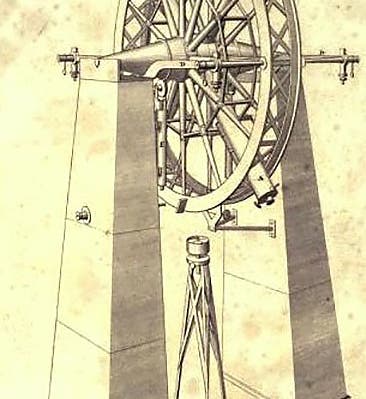Scientist of the Day - Edward Troughton
Edward Troughton, an English instrument maker, died on June 12, 1835; he was born on an unknown day in 1753. Troughton built and sold a variety of astronomical instruments and telescopes; today, we are going to focus on his specialty, the transit instrument. A transit instrument is one that is fixed to swing only along the meridian, which is the great circle that passes through the zenith (the point directly overhead), and the north and south celestial poles. This means it must be mounted on a horizontal east-west axis. The first transit instrument was built by Tycho Brahe around 1580 for his observatory at Uraniborg; it consisted of a large quadrant mounted to a wall that was aligned in a north-south direction, and hence was called a mural quadrant. Since the telescope had not yet been invented, Tycho’s quadrant used naked-eye sights. The advantage of such an instrument is that when a star passes across the meridian, its altitude can be measured, and, if the time of transit is determined as well, the star’s celestial longitude and latitude can be calculated, which are the two components of a celestial cartographic system, known as the ecliptic coordinate system, which has been used since antiquity.
A transit circle is a bit different in that it is literally a large circle aligned with the meridian, with a telescope rigidly attached. The fact that it is a complete circle means that the scale attached to the circle can be made much more accurate. Ole Rømer built the first transit circle around 1690 (the first image shown at the link is not the transit circle, but rather a meridian telescope, explained here below). Romer also recognized a real advantage of the transit circle; at the moment a star crosses the meridian, the angular position of the telescope will give you directly the declination of the star, declination being one of the two coordinates in the other important celestial system, the equatorial coordinate system, a more recent but increasingly popular system for positioning the stars. The time of passage across the meridian will provide the right ascension, which is the other coordinate. Consequently, the star's position can be determined without any calculation at all (if we disregard such complications as refraction, aberration, etc.). Surprisingly, most later builders of transit instruments did not use this advantage, but continued to determine celestial longitude and latitude, with assistants being put to work to do the necessary calculations. This was the case with Jesse Ramsden's great transit circle of 5-foot diameter, which he built for the observatory at Palermo in 1789. We wrote a post once on Ramsden and the Palermo circle, which you can read here, with images of his instrument.
Troughton's instruments were built to measure right ascension and declination, and they were more accurate than any instruments that preceded them. In 1806, he built a transit circle for Stephen Groombridge in Blackheath. Using Troughton’s circle, Groombridge prepared a catalogue of circumpolar stars, which was published in 1838. We have this work in our Library. It may contain an engraving of the transit circle, but our Library collections are still off-limits. Instead we show you an engraving from Wikipedia that is claimed to be from the 1838 catalog, but which needs verification (first image).
Surprisingly, after the success of his great transit circle, Troughton reverted to building transit telescopes, which lack the circular scale, and hence cannot be used to measure declination. Apparently the transit telescopes, which simply swing up and down along the meridian, could determine right ascension more accurately than the transit circles. Troughton built a transit instrument for the Greenwich Observatory, which was installed in 1816. Ten feet long, it replaced an 8-foot instrument, and so the piers that support the horizontal axis had to be raised to accommodate the longer instrument. And the meridian it swung on was not just any meridian, but the Greenwich meridian, which would later become the Prime Meridian. It was used primarily to determine the transit times of certain “clock stars” in order to keep the Greenwich clocks accurate. It did so until 1850, when it was replaced by an even better instrument. Troughton’s ten-foot transit instrument has been preserved and is on display today in Flamsteed House at Greenwich, on piers designed to replicate the originals, as we see in a modern photograph (second image).
The basic textbook on optics in the 18th and early 19th-century was Robert Smith's A Compleat System of Opticks (1738). We know that Edward Troughton had a copy, because that copy, with his signature on the title page, resides in our History of Science Collection. You will not find this important provenance fact in the Library’s online catalog, which is disheartening. We are sorry that we cannot show you Troughton’s signature at the present time.
Troughton was included in the engraving “Distinguished Men of Science Living in 1807-8” (1862), that we have featured many times in this series of posts; you can see the original engraving in the National Portrait Gallery, as well as a numbered key that identifies the sitters. Troughton is no. 41, in the back at the right, next to Bryan Donkin, who invented the tin can. The features of Troughton in the engraving appear to have been taken from a bust of Troughton that was commissioned by his admirers in 1825, and which is said to be in the collections of the Royal Museums Greenwich.
Dr. William B. Ashworth, Jr., Consultant for the History of Science, Linda Hall Library and Associate Professor emeritus, Department of History, University of Missouri-Kansas City. Comments or corrections are welcome; please direct to ashworthw@umkc.edu.







